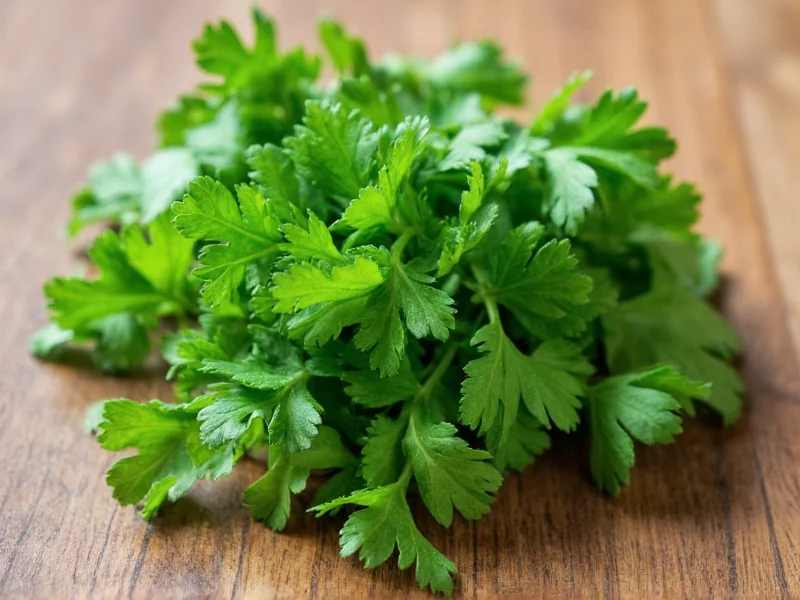Understanding the difference between Italian parsley and cilantro is essential for home cooks and culinary enthusiasts. Many people mistakenly believe these herbs are interchangeable due to their similar leaf shapes, but their flavors couldn't be more different. Italian parsley offers a mild, slightly peppery taste with grassy notes, making it versatile across cuisines. Cilantro, however, delivers a bold, citrusy flavor that some describe as soapy (a genetic predisposition affecting about 21% of the population).
Visual Comparison of Italian Parsley vs Cilantro
| Characteristic | Italian Parsley | Cilantro |
|---|---|---|
| Leaf Shape | Flat, broad leaves with serrated edges | Delicate, lacy, rounded leaves |
| Stem Color | Light green to pale yellow | Purple-tinged at the base |
| Plant Height | 12-18 inches | 18-24 inches |
| Root System | Taproot | Taproot (also used as coriander) |
Botanical Classification Explained
Italian parsley, also known as flat-leaf parsley, is a variety of Petroselinum crispum with the subspecies designation neapolitanum. It's closely related to other Apiaceae family members like celery and carrots. Cilantro, meanwhile, is the leafy part of the Coriandrum sativum plant, which also produces coriander seeds. Though both belong to the same plant family (Apiaceae), they're as different from each other as carrots are from celery.
The confusion between Italian parsley and cilantro often stems from regional naming differences. In some parts of the world, particularly in Latin America, cilantro is sometimes mistakenly called "Chinese parsley," which further muddies the waters. However, true parsley varieties—including both Italian (flat-leaf) and curly parsley—share similar flavor profiles that differ significantly from cilantro's distinctive taste.
Culinary Applications and Substitution Guidelines
When exploring the difference between Italian parsley and cilantro in cooking, their applications reveal fundamental distinctions. Italian parsley serves as a versatile finishing herb in Mediterranean, European, and Middle Eastern cuisines. Chefs value its ability to add freshness without overwhelming other flavors, making it perfect for gremolata, tabbouleh, and as a garnish for grilled meats.
Cilantro, by contrast, is essential in Latin American, Indian, and Southeast Asian cooking. Its bold flavor stands up to spicy ingredients and forms the base of salsas, chutneys, and curry pastes. The seeds (coriander) offer a completely different, citrusy-spicy profile used in baking and spice blends.
Can you substitute Italian parsley for cilantro? In some recipes, yes—but with important caveats. For dishes where cilantro plays a supporting role, Italian parsley can work as a substitute, though you'll miss the distinctive citrus notes. Never substitute parsley for cilantro in recipes where cilantro is the star ingredient, like in fresh pico de gallo or Thai curry pastes. The flavor difference would significantly alter the dish's character.
Common Misconceptions Clarified
One persistent myth suggests that Italian parsley and cilantro are the same plant harvested at different times. This is incorrect—these are genetically distinct plants that grow differently and produce different chemical compounds responsible for their unique flavors.
Another misconception involves the so-called "cilantro soap gene." Approximately 21% of people possess a genetic variation that makes cilantro taste like soap to them. This genetic factor doesn't affect how these individuals perceive Italian parsley, which lacks the specific aldehydes that trigger the soapy perception in cilantro.
Selection and Storage Tips
When shopping for Italian parsley vs cilantro, look for vibrant green leaves without yellowing or wilting. Italian parsley should have firm, crisp stems, while cilantro often shows more delicate stems with possible purple tinges at the base.
For storage, treat both herbs similarly: trim the stems, place in a glass with an inch of water, and cover loosely with a plastic bag in the refrigerator. Italian parsley typically lasts 1-2 weeks, while cilantro is more perishable, lasting about 5-7 days. For longer storage, chop and freeze both herbs in ice cube trays with water or oil.
Frequently Asked Questions
Can I use Italian parsley instead of cilantro in guacamole?
While you can technically substitute Italian parsley for cilantro in guacamole, the flavor profile will change significantly. Cilantro's citrus notes complement avocado's richness, while Italian parsley offers a milder, grassier flavor. If you dislike cilantro or can't find it, use half the amount of Italian parsley and add a squeeze of lime to approximate the flavor balance.
Why do some people think Italian parsley and cilantro are the same?
The confusion between Italian parsley and cilantro stems from their similar leaf shapes and both being used as fresh herbs. Additionally, in some regions, cilantro is mistakenly called "Chinese parsley," creating further misunderstanding. Their botanical differences and distinct flavor profiles confirm they are separate herbs despite superficial visual similarities.
What's the best substitute for cilantro if I don't like its taste?
If you dislike cilantro's flavor (possibly due to the soapy taste perception), the best substitutes depend on the recipe. For fresh applications like salsas, try a combination of Italian parsley and fresh mint. For cooked dishes, consider using culantro (a different herb with similar flavor but more heat-stable) or simply omit it and enhance other flavors with extra lime juice and black pepper.
Does Italian parsley have the same nutritional benefits as cilantro?
Both herbs offer nutritional benefits but with different profiles. Italian parsley is exceptionally high in vitamin K (providing over 100% of daily needs in just 10 sprigs) and vitamin C. Cilantro contains similar vitamins but in different proportions and offers unique antioxidants like quercetin. Both contribute to a healthy diet but shouldn't be considered nutritionally identical due to their different phytochemical compositions.











 浙公网安备
33010002000092号
浙公网安备
33010002000092号 浙B2-20120091-4
浙B2-20120091-4